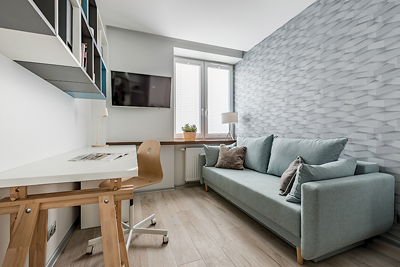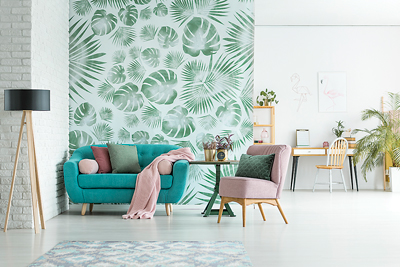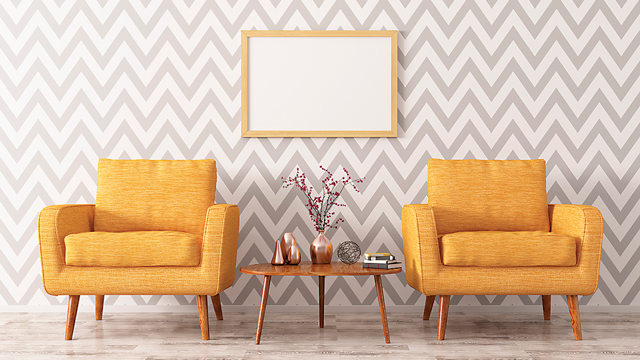When it comes to changing the look of a room, a homeowner’s first instinct is usually to repaint. Paint can be inexpensive, and often, it seems like a do-it-yourself job. But maybe it’s time to reconsider wallpaper – in all its forms.
Thanks to increased options in materials, designs, and adhesives, wall coverings are making a comeback. Yes, it’s true that years ago, wallpaper was typically found in formal living spaces with patterns and images that many considered dated and was assumed to be virtually impossible to remove without damaging the wall underneath. Not anymore.
Why Wallpaper?
First, homeowners should realize that wallpaper never fell out of favor in commercial spaces and high-end residential homes. Wallpaper provides protection for walls that paint simply doesn’t, by establishing an actual barrier between human contact and the wall itself, actually deflecting incidental contact.
Second, consider your options. Wallpaper offers a near-endless range of textures, patterns, and colors. A few sheets of wallpaper can create a striped room in a day, a look that could only be achieved with paint after hours of meticulous measuring and taping. Strategically hang wall coverings to highlight – or create – a focal point in a room or conceal problem areas by drawing the eye elsewhere.
Finally, there is the cost. Yes, wallpaper is more expensive than paint. But it’s also more durable. A high-quality covering can last twenty years. Even if you aren’t sure you want to sign on for that length of time, wallpaper’s durability keeps it fresh longer than painted walls, which can fade and chip, especially if the paint applied isn’t of the best quality. One wall covering project can easily outlast multiple paint jobs, which can save money in the long run.

Product Improvements
Get past the word wallpaper. Sure, what you hang on your wall might be paper. But it might be fabric. Or vinyl. Or foil. Or paper with LED lights embedded. (No kidding!)
Wallpaper can feature bucolic countryside scenes, or images of trees that reach from floor to ceiling, or repeating geometric images, or oversized flowers that don’t even exist in nature.
Best of all, wallpaper can be removed without damaging your walls or your psyche. (Well, if you do your advance work.)
For years, the adhesive used to hang wallpaper was – quite literally – wheat paste and water. While wheat paste is still used, new adhesive options have been developed, each with different properties. Because these adhesives are specific to the type of covering, they promote easy removal. Plus, adhesives can be purchased pre-mixed or even pre-applied to the covering itself, minimizing opportunity for mistakes, additional steps, and wasted time.
As savvy DIYers know, preparation is key with many home projects, and using wall covering is no exception. Primer specifically formulated for wallpaper application is a must, and liner – as it sounds, an actual layer between the paper and the wall – helps to ensure that removal goes smoothly.
If you’re really looking for simple, though, consider peel-and-stick options, readily available in playful, formal, and abstract designs. These papers, often vinyl, are easy to place and easy to change, and they provide quick home fashion accents without a significant investment of time.

Make a Statement
If you’ve never decorated with wallcovering before, it’s best to start with a smaller project so you can get the hang of it (pun intended!). Foyers and entryways are small spaces that can make a big impact, but they can be tricky with staircases and corners created by doorways or room openings.
The best place to learn is often a dining room, especially above a chair rail. Dining rooms are usually square and have few variables. Plus, you don’t have to worry about keeping 9-foot sheets of material straight; the space between rail and ceiling may be just four or five feet high.
Another fun project is an accent wall. Paper can be selected to coordinate with existing paint and furniture, so you don’t have to commit to a full room re-do. But the wallpaper addition enlivens a quiet space, making it modern and fresh.
To be even more targeted, just cover a section of wall – like the area above a fireplace or behind a sofa or side table. This creates an accent as opposed to an environment. Wallpaper can also be cut into any shape to become original artwork. Or, you might frame samples and hang them. If you have built-in shelving, whether in the kitchen or an office, consider applying wallpaper on the inside walls, which will draw attention to collectibles.
Whatever the approach, plenty of guidance is available either online or from local retailers. Step out of your comfort zone and consider wallpaper. Embrace a look that has decorated homes for hundreds of years and truly is fresh again.




